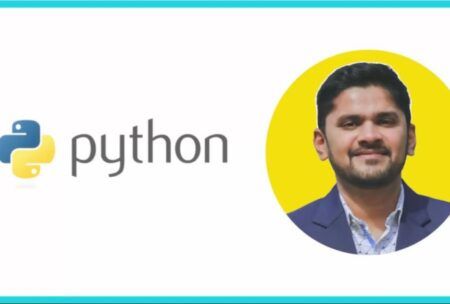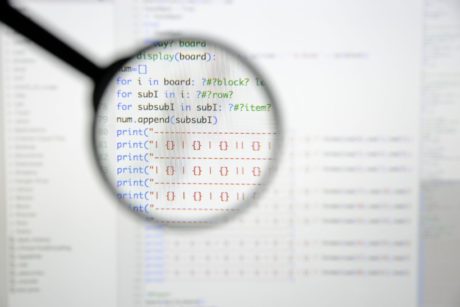Learn basic and advanced programming in this Python In 5 Hours course and build a firm Python foundation for your programming career. Read more.
I am the founder of Studyopedia.com. We provide self-paced courses with video lessons, notes, quizzes, interview questions, answers, etc. Taught millions of students and professionals through our video courses, website, and content, covering multiple programming languages and technologies. Skills and Courses cover programming languages, databases, frameworks, etc. i.e. Python, Data Science, Machine Learning, Java, Android, C, C++, HTML5, Bootstrap, JavaScript, jQuery, PHP, CSS, WordPress, Dru
Access all courses in our library for only $9/month with All Access Pass
Get Started with All Access PassBuy Only This CourseAbout This Course
Who this course is for:
- Beginner Programmers who want to master Python Programming
- Python Programmers aiming to enhance their Python Programming skills
- Students and Engineers who are in Programming as an academic subject in school
- Professional Programmers who want to switch to Python Programming
What you’ll learn:
- Program in Python professionally
- Get hands-on experience and solve coding exercises
- How to become fluent in Python
- The skills to showcase Python Programming expertise
- Basic and advanced Python Programming
- Build on a firm foundation in Python for the rest of your career
Requirements:
- No prior knowledge is required to take this course
Python is a robust, interpreted, and object-oriented programming language with widespread applications in development, making it an ideal choice for scripting tasks. Conceived by Guido van Rossum and introduced in 1991, Python has become an indispensable skill for data science, with over 75% of programmers recognizing its importance in this field.
In this Learn Python In 5 Hours video course, we have covered Python Basics and Advanced concepts. It comprises 83 lessons and 200+ live running source codes (downloadable), including Functions, Classes and Objects, Dictionary, Lists, Sets, Tuples, etc. We have also covered Modules, including Maths, Statistics, Random, etc.
Explore this and more in this Learn Python In 5 Hours course.
Check out my other course Microsoft SQL Server Course For Beginners With 100+ Examples and add another expertise to your Technology learning journey.
Our Promise to You
By the end of this course, you will have learned beginner to advanced Python Programming.
10 Day Money Back Guarantee. If you are unsatisfied for any reason, simply contact us and we’ll give you a full refund. No questions asked.
Get started today!
Course Curriculum
| Section 1 - Introduction | |||
| Python Course Introduction | 00:00:00 | ||
| Python Introduction And Features | 00:00:00 | ||
| Python Introduction - PDF | 00:00:00 | ||
| Section 2 - Set Up | |||
| Install Python On Windows | 00:00:00 | ||
| Install PyCharm | 00:00:00 | ||
| Setup Python Interpreter In PyCharm | 00:00:00 | ||
| Run First Python Project | 00:00:00 | ||
| Section 3 - Variables | |||
| What Are Variables In Python? | 00:00:00 | ||
| Coding Example - Variables | 00:00:00 | ||
| Python Variables - PDF | 00:00:00 | ||
| Codes - Python Variables | 00:00:00 | ||
| Section 4 - Scope Of Variables | |||
| What Are Scope Of Variables? | 00:00:00 | ||
| Local Scope | 00:00:00 | ||
| Global Scope | 00:00:00 | ||
| Global Keyword: Change The Value Of A Global Variable | 00:00:00 | ||
| Scope Of Variables - PDF | 00:00:00 | ||
| Codes - Scope Of Variables | 00:00:00 | ||
| Section 5 - Tokens | |||
| What Are Tokens And Its Types? | 00:00:00 | ||
| Keywords | 00:00:00 | ||
| Identifiers | 00:00:00 | ||
| Literals | 00:00:00 | ||
| Tokens - PDF | 00:00:00 | ||
| Codes - Tokens | 00:00:00 | ||
| Section 6 - Operators | |||
| What Are Operators? | 00:00:00 | ||
| Arithmetic Operators | 00:00:00 | ||
| Assignment Operators | 00:00:00 | ||
| Logical Operators | 00:00:00 | ||
| Identity Operators | 00:00:00 | ||
| Membership Operators | 00:00:00 | ||
| Bitwise Operators | 00:00:00 | ||
| Operators - PDF | 00:00:00 | ||
| Codes - Python Operators | 00:00:00 | ||
| Section 7 - Comments | |||
| What Are Comments? | 00:00:00 | ||
| Single-Line And Multi-Line Comments | 00:00:00 | ||
| Comments - PDF | 00:00:00 | ||
| Codes - Comments | 00:00:00 | ||
| Section 8 - Type Conversion | |||
| What Is Type Conversion In Python? | 00:00:00 | ||
| Coding Examples | 00:00:00 | ||
| Type Conversion - PDF | 00:00:00 | ||
| Codes - Type Conversion | 00:00:00 | ||
| Section 9 - Get User Input | |||
| How To Get User Input - With Example | 00:00:00 | ||
| User Input - PDF | 00:00:00 | ||
| Codes - User Input | 00:00:00 | ||
| Section 10 - Decision Making Statements | |||
| What Are Decision Making Statements In Python? | 00:00:00 | ||
| if statement | 00:00:00 | ||
| if else statement | 00:00:00 | ||
| if elif else | 00:00:00 | ||
| Decision Making Statements - PDF | 00:00:00 | ||
| Codes - Decision Making Statements | 00:00:00 | ||
| Section 11 - break And continue Statements | |||
| break Statement | 00:00:00 | ||
| continue Statement | 00:00:00 | ||
| break and continue Statements - PDF | 00:00:00 | ||
| Codes - break And continue Statements | 00:00:00 | ||
| Section 12 - Loops | |||
| What Are Loops? | 00:00:00 | ||
| while Loop | 00:00:00 | ||
| for Loop | 00:00:00 | ||
| Loops - PDF | 00:00:00 | ||
| Codes - Loops | 00:00:00 | ||
| Section 13 - Numbers | |||
| What Are Numeric Datatypes? | 00:00:00 | ||
| Types - Integer, Long, Float, Complex Datatypes | 00:00:00 | ||
| Numbers - PDF | 00:00:00 | ||
| Codes - Numbers | 00:00:00 | ||
| Section 14 - Strings | |||
| What Are Strings? | 00:00:00 | ||
| Create A String In Python | 00:00:00 | ||
| String Literals | 00:00:00 | ||
| Slicing To Access Substrings | 00:00:00 | ||
| Negative Indexing To Access Substrings | 00:00:00 | ||
| Accessing A Character In Python Strings | 00:00:00 | ||
| Concatenate Strings | 00:00:00 | ||
| Built-In String Methods - Coding Examples | 00:00:00 | ||
| Strings - PDF | 00:00:00 | ||
| Codes - Strings | 00:00:00 | ||
| Section 15 - Functions | |||
| What Are Functions? | 00:00:00 | ||
| Create And Call A Function | 00:00:00 | ||
| Create A Function With Parameters | 00:00:00 | ||
| Function Arguments | 00:00:00 | ||
| Recursion | 00:00:00 | ||
| The Return Statement | 00:00:00 | ||
| Functions - PDF | 00:00:00 | ||
| Codes - Functions | 00:00:00 | ||
| Section 16 - Lambda Functions | |||
| What Are Lambda Functions? | 00:00:00 | ||
| Coding Examples | 00:00:00 | ||
| Lambda Functions - PDF | 00:00:00 | ||
| Codes - Lambda Functions | 00:00:00 | ||
| Section 17 - Classes And Objects | |||
| Classes And Objects - Introduction | 00:00:00 | ||
| What Is A Class? How To Create? | 00:00:00 | ||
| What Is An Object? | 00:00:00 | ||
| Examples - Classes And Objects | 00:00:00 | ||
| _init_() Function | 00:00:00 | ||
| Classes And Objects - PDF | 00:00:00 | ||
| Codes - Classes And Objects | 00:00:00 | ||
| Section 18 - Tuples | |||
| What Are Tuples In Python? | 00:00:00 | ||
| Difference Between Tuples And Lists | 00:00:00 | ||
| Create A Tuple In Python? | 00:00:00 | ||
| Tuples - Coding Examples | 00:00:00 | ||
| Tuples - PDF | 00:00:00 | ||
| Codes - Tuples | 00:00:00 | ||
| Section 19 - Dictionary | |||
| What Are Dictionaries In Python? | 00:00:00 | ||
| How To Create A Dictionary | 00:00:00 | ||
| Coding Examples - Dictionary | 00:00:00 | ||
| Dictionary - PDF | 00:00:00 | ||
| Codes - Dictionary | 00:00:00 | ||
| Section 20 - Lists | |||
| What Are Lists In Python? | 00:00:00 | ||
| Difference Between Tuples And Lists | 00:00:00 | ||
| Coding Examples - Lists | 00:00:00 | ||
| Join Lists | 00:00:00 | ||
| Multi-Dimensional Python List | 00:00:00 | ||
| Lists - PDF | 00:00:00 | ||
| Codes - Lists | 00:00:00 | ||
| Section 21 - Sets | |||
| What Are Sets In Python | 00:00:00 | ||
| How To Create A Set | 00:00:00 | ||
| Coding Examples - Sets | 00:00:00 | ||
| Sets - PDF | 00:00:00 | ||
| Codes - Sets | 00:00:00 | ||
| Section 22 - Modules | |||
| What Are Python Modules? | 00:00:00 | ||
| How To Load A Module In Python? | 00:00:00 | ||
| Modules - PDF | 00:00:00 | ||
| Section 23 - Math Module | |||
| What Is A Math Module And How To Import? | 00:00:00 | ||
| Coding Examples - Math Module Functions | 00:00:00 | ||
| Math Module - PDF | 00:00:00 | ||
| Codes - Math Module | 00:00:00 | ||
| Section 24 - Statistics Module | |||
| What Is A Statistics Module And How To Import? | 00:00:00 | ||
| Coding Examples - Statistics Module Functions | 00:00:00 | ||
| Statistics Module - PDF | 00:00:00 | ||
| Codes - Statistics Module | 00:00:00 | ||
| Section 25 - Random Module | |||
| What Is A Random Module And How To import? | 00:00:00 | ||
| Coding Examples - Random Module Functions | 00:00:00 | ||
| Random Module - PDF | 00:00:00 | ||
| Codes - Random Module | 00:00:00 | ||
About This Course
Who this course is for:
- Beginner Programmers who want to master Python Programming
- Python Programmers aiming to enhance their Python Programming skills
- Students and Engineers who are in Programming as an academic subject in school
- Professional Programmers who want to switch to Python Programming
What you’ll learn:
- Program in Python professionally
- Get hands-on experience and solve coding exercises
- How to become fluent in Python
- The skills to showcase Python Programming expertise
- Basic and advanced Python Programming
- Build on a firm foundation in Python for the rest of your career
Requirements:
- No prior knowledge is required to take this course
Python is a robust, interpreted, and object-oriented programming language with widespread applications in development, making it an ideal choice for scripting tasks. Conceived by Guido van Rossum and introduced in 1991, Python has become an indispensable skill for data science, with over 75% of programmers recognizing its importance in this field.
In this Learn Python In 5 Hours video course, we have covered Python Basics and Advanced concepts. It comprises 83 lessons and 200+ live running source codes (downloadable), including Functions, Classes and Objects, Dictionary, Lists, Sets, Tuples, etc. We have also covered Modules, including Maths, Statistics, Random, etc.
Explore this and more in this Learn Python In 5 Hours course.
Check out my other course Microsoft SQL Server Course For Beginners With 100+ Examples and add another expertise to your Technology learning journey.
Our Promise to You
By the end of this course, you will have learned beginner to advanced Python Programming.
10 Day Money Back Guarantee. If you are unsatisfied for any reason, simply contact us and we’ll give you a full refund. No questions asked.
Get started today!
Course Curriculum
| Section 1 - Introduction | |||
| Python Course Introduction | 00:00:00 | ||
| Python Introduction And Features | 00:00:00 | ||
| Python Introduction - PDF | 00:00:00 | ||
| Section 2 - Set Up | |||
| Install Python On Windows | 00:00:00 | ||
| Install PyCharm | 00:00:00 | ||
| Setup Python Interpreter In PyCharm | 00:00:00 | ||
| Run First Python Project | 00:00:00 | ||
| Section 3 - Variables | |||
| What Are Variables In Python? | 00:00:00 | ||
| Coding Example - Variables | 00:00:00 | ||
| Python Variables - PDF | 00:00:00 | ||
| Codes - Python Variables | 00:00:00 | ||
| Section 4 - Scope Of Variables | |||
| What Are Scope Of Variables? | 00:00:00 | ||
| Local Scope | 00:00:00 | ||
| Global Scope | 00:00:00 | ||
| Global Keyword: Change The Value Of A Global Variable | 00:00:00 | ||
| Scope Of Variables - PDF | 00:00:00 | ||
| Codes - Scope Of Variables | 00:00:00 | ||
| Section 5 - Tokens | |||
| What Are Tokens And Its Types? | 00:00:00 | ||
| Keywords | 00:00:00 | ||
| Identifiers | 00:00:00 | ||
| Literals | 00:00:00 | ||
| Tokens - PDF | 00:00:00 | ||
| Codes - Tokens | 00:00:00 | ||
| Section 6 - Operators | |||
| What Are Operators? | 00:00:00 | ||
| Arithmetic Operators | 00:00:00 | ||
| Assignment Operators | 00:00:00 | ||
| Logical Operators | 00:00:00 | ||
| Identity Operators | 00:00:00 | ||
| Membership Operators | 00:00:00 | ||
| Bitwise Operators | 00:00:00 | ||
| Operators - PDF | 00:00:00 | ||
| Codes - Python Operators | 00:00:00 | ||
| Section 7 - Comments | |||
| What Are Comments? | 00:00:00 | ||
| Single-Line And Multi-Line Comments | 00:00:00 | ||
| Comments - PDF | 00:00:00 | ||
| Codes - Comments | 00:00:00 | ||
| Section 8 - Type Conversion | |||
| What Is Type Conversion In Python? | 00:00:00 | ||
| Coding Examples | 00:00:00 | ||
| Type Conversion - PDF | 00:00:00 | ||
| Codes - Type Conversion | 00:00:00 | ||
| Section 9 - Get User Input | |||
| How To Get User Input - With Example | 00:00:00 | ||
| User Input - PDF | 00:00:00 | ||
| Codes - User Input | 00:00:00 | ||
| Section 10 - Decision Making Statements | |||
| What Are Decision Making Statements In Python? | 00:00:00 | ||
| if statement | 00:00:00 | ||
| if else statement | 00:00:00 | ||
| if elif else | 00:00:00 | ||
| Decision Making Statements - PDF | 00:00:00 | ||
| Codes - Decision Making Statements | 00:00:00 | ||
| Section 11 - break And continue Statements | |||
| break Statement | 00:00:00 | ||
| continue Statement | 00:00:00 | ||
| break and continue Statements - PDF | 00:00:00 | ||
| Codes - break And continue Statements | 00:00:00 | ||
| Section 12 - Loops | |||
| What Are Loops? | 00:00:00 | ||
| while Loop | 00:00:00 | ||
| for Loop | 00:00:00 | ||
| Loops - PDF | 00:00:00 | ||
| Codes - Loops | 00:00:00 | ||
| Section 13 - Numbers | |||
| What Are Numeric Datatypes? | 00:00:00 | ||
| Types - Integer, Long, Float, Complex Datatypes | 00:00:00 | ||
| Numbers - PDF | 00:00:00 | ||
| Codes - Numbers | 00:00:00 | ||
| Section 14 - Strings | |||
| What Are Strings? | 00:00:00 | ||
| Create A String In Python | 00:00:00 | ||
| String Literals | 00:00:00 | ||
| Slicing To Access Substrings | 00:00:00 | ||
| Negative Indexing To Access Substrings | 00:00:00 | ||
| Accessing A Character In Python Strings | 00:00:00 | ||
| Concatenate Strings | 00:00:00 | ||
| Built-In String Methods - Coding Examples | 00:00:00 | ||
| Strings - PDF | 00:00:00 | ||
| Codes - Strings | 00:00:00 | ||
| Section 15 - Functions | |||
| What Are Functions? | 00:00:00 | ||
| Create And Call A Function | 00:00:00 | ||
| Create A Function With Parameters | 00:00:00 | ||
| Function Arguments | 00:00:00 | ||
| Recursion | 00:00:00 | ||
| The Return Statement | 00:00:00 | ||
| Functions - PDF | 00:00:00 | ||
| Codes - Functions | 00:00:00 | ||
| Section 16 - Lambda Functions | |||
| What Are Lambda Functions? | 00:00:00 | ||
| Coding Examples | 00:00:00 | ||
| Lambda Functions - PDF | 00:00:00 | ||
| Codes - Lambda Functions | 00:00:00 | ||
| Section 17 - Classes And Objects | |||
| Classes And Objects - Introduction | 00:00:00 | ||
| What Is A Class? How To Create? | 00:00:00 | ||
| What Is An Object? | 00:00:00 | ||
| Examples - Classes And Objects | 00:00:00 | ||
| _init_() Function | 00:00:00 | ||
| Classes And Objects - PDF | 00:00:00 | ||
| Codes - Classes And Objects | 00:00:00 | ||
| Section 18 - Tuples | |||
| What Are Tuples In Python? | 00:00:00 | ||
| Difference Between Tuples And Lists | 00:00:00 | ||
| Create A Tuple In Python? | 00:00:00 | ||
| Tuples - Coding Examples | 00:00:00 | ||
| Tuples - PDF | 00:00:00 | ||
| Codes - Tuples | 00:00:00 | ||
| Section 19 - Dictionary | |||
| What Are Dictionaries In Python? | 00:00:00 | ||
| How To Create A Dictionary | 00:00:00 | ||
| Coding Examples - Dictionary | 00:00:00 | ||
| Dictionary - PDF | 00:00:00 | ||
| Codes - Dictionary | 00:00:00 | ||
| Section 20 - Lists | |||
| What Are Lists In Python? | 00:00:00 | ||
| Difference Between Tuples And Lists | 00:00:00 | ||
| Coding Examples - Lists | 00:00:00 | ||
| Join Lists | 00:00:00 | ||
| Multi-Dimensional Python List | 00:00:00 | ||
| Lists - PDF | 00:00:00 | ||
| Codes - Lists | 00:00:00 | ||
| Section 21 - Sets | |||
| What Are Sets In Python | 00:00:00 | ||
| How To Create A Set | 00:00:00 | ||
| Coding Examples - Sets | 00:00:00 | ||
| Sets - PDF | 00:00:00 | ||
| Codes - Sets | 00:00:00 | ||
| Section 22 - Modules | |||
| What Are Python Modules? | 00:00:00 | ||
| How To Load A Module In Python? | 00:00:00 | ||
| Modules - PDF | 00:00:00 | ||
| Section 23 - Math Module | |||
| What Is A Math Module And How To Import? | 00:00:00 | ||
| Coding Examples - Math Module Functions | 00:00:00 | ||
| Math Module - PDF | 00:00:00 | ||
| Codes - Math Module | 00:00:00 | ||
| Section 24 - Statistics Module | |||
| What Is A Statistics Module And How To Import? | 00:00:00 | ||
| Coding Examples - Statistics Module Functions | 00:00:00 | ||
| Statistics Module - PDF | 00:00:00 | ||
| Codes - Statistics Module | 00:00:00 | ||
| Section 25 - Random Module | |||
| What Is A Random Module And How To import? | 00:00:00 | ||
| Coding Examples - Random Module Functions | 00:00:00 | ||
| Random Module - PDF | 00:00:00 | ||
| Codes - Random Module | 00:00:00 | ||



